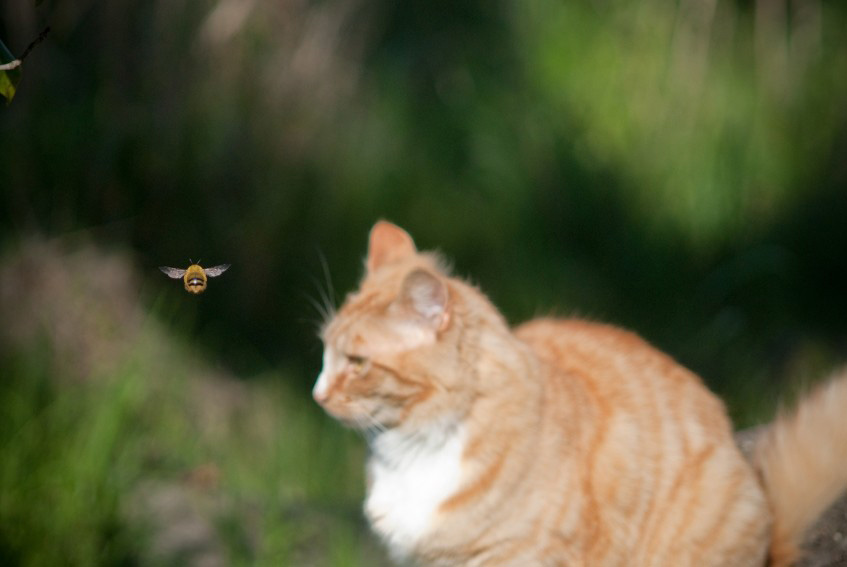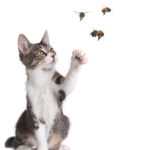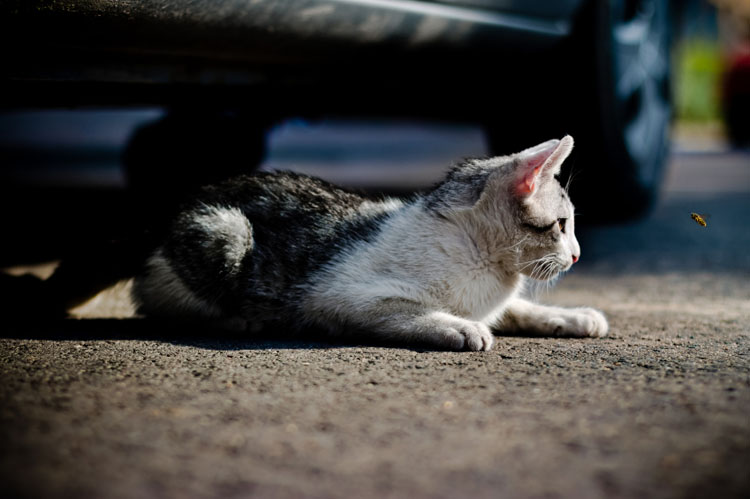The Cats and the Bees
 Did you know that July 10 was “Don’t Step on a Bee Day.” Seriously, who comes up with this stuff? If you don’t believe me, go to a website called DaysOfTheYear.com and check this out along with national waffle day and national gummi bear day…
Did you know that July 10 was “Don’t Step on a Bee Day.” Seriously, who comes up with this stuff? If you don’t believe me, go to a website called DaysOfTheYear.com and check this out along with national waffle day and national gummi bear day…
The whole idea of this day is to help preserve bees, which are in danger in many parts of the world. While saving bees is a good thing, they can present a problem when you have cats. Cats find them irresistible to watch, chase—and catch.
We have a succulent on our balcony where the cats are allowed to sit safely and sun themselves. Every year it produces a huge stem with hundreds of tiny yellow flowers and with it comes the bees that probably get more pollen from this one stop than from flitting from flower to flower.
Fudge couldn’t care less. Been there done that—this occurs every year. But Ziggy is fixated, watching their every movement. It must make him dizzy when several bees arrive at once and flit all over this huge flowering stem. When one bee lost its sense of direction and flew inside Ziggy took after it at high speed. I had to spring into action to prevent ensuing conflict.
After a couple of weeks of this, I realized I couldn’t sit and watch Ziggy watching the bees any longer because eventually he could catch one and probably get stung, so I cut off the huge stem and put into it into a vase instead.
 What do you do if your cat gets stung on her nose, paws or anywhere else? First off, if possible, get the entire stinger out. (Note: wasps, yellow jackets, hornets and bumble bees don’t leave their “stingers” behind.) A credit card is your best friend when it comes to removing a stinger. Use the credit card to scrape it away, making sure you get the whole stinger. Don’t use tweezers or your fingers as you might end up releasing more venom into or onto your cat. A sting won’t be too painful for your cat, according to veterinarians, but the site can swell up quickly. Ice will help reduce the swelling and it’s also a good idea to apply an antibiotic cream.
What do you do if your cat gets stung on her nose, paws or anywhere else? First off, if possible, get the entire stinger out. (Note: wasps, yellow jackets, hornets and bumble bees don’t leave their “stingers” behind.) A credit card is your best friend when it comes to removing a stinger. Use the credit card to scrape it away, making sure you get the whole stinger. Don’t use tweezers or your fingers as you might end up releasing more venom into or onto your cat. A sting won’t be too painful for your cat, according to veterinarians, but the site can swell up quickly. Ice will help reduce the swelling and it’s also a good idea to apply an antibiotic cream.
A friend’s cat chomped on a bee and got stung inside his cheek. That necessitated a trip to the vet and an antihistamine injection. In fact, any bee sting is definitely worth a follow up to the vet because cats can have an allergic reaction and go into shock. They might have difficulty breathing if the tissues of the throat swell. In addition, their blood pressure could plunge, resulting in a life-threatening complication. If your cat exhibits any of these symptoms after being stung, take her to a veterinarian immediately.
Sorry bees. Next year when this plant flowers, I am going to cut off the flowering stem and put it in a vase straight away. I am going to buy Ziggy a toy that replicates a bee on a wand and play with him instead.
About the Author: Sandy Robins is the 2013 winner of the “Excellence in Journalism and Outstanding Contribution to the Pet Industry Award.” Her work appears on many of the country’s leading pet platforms, such as MSNBC.com, MSN.com and TODAYShow.com. She is a regular contributor and columnist in multiple national and international publications, including Cat Fancy, as well as the author of the award-winning books “Fabulous Felines: Health and Beauty Secrets for the Pampered Cat” and “For The Love of Cats.” Learn more about Sandy on her website or Facebook page. #welovecats






